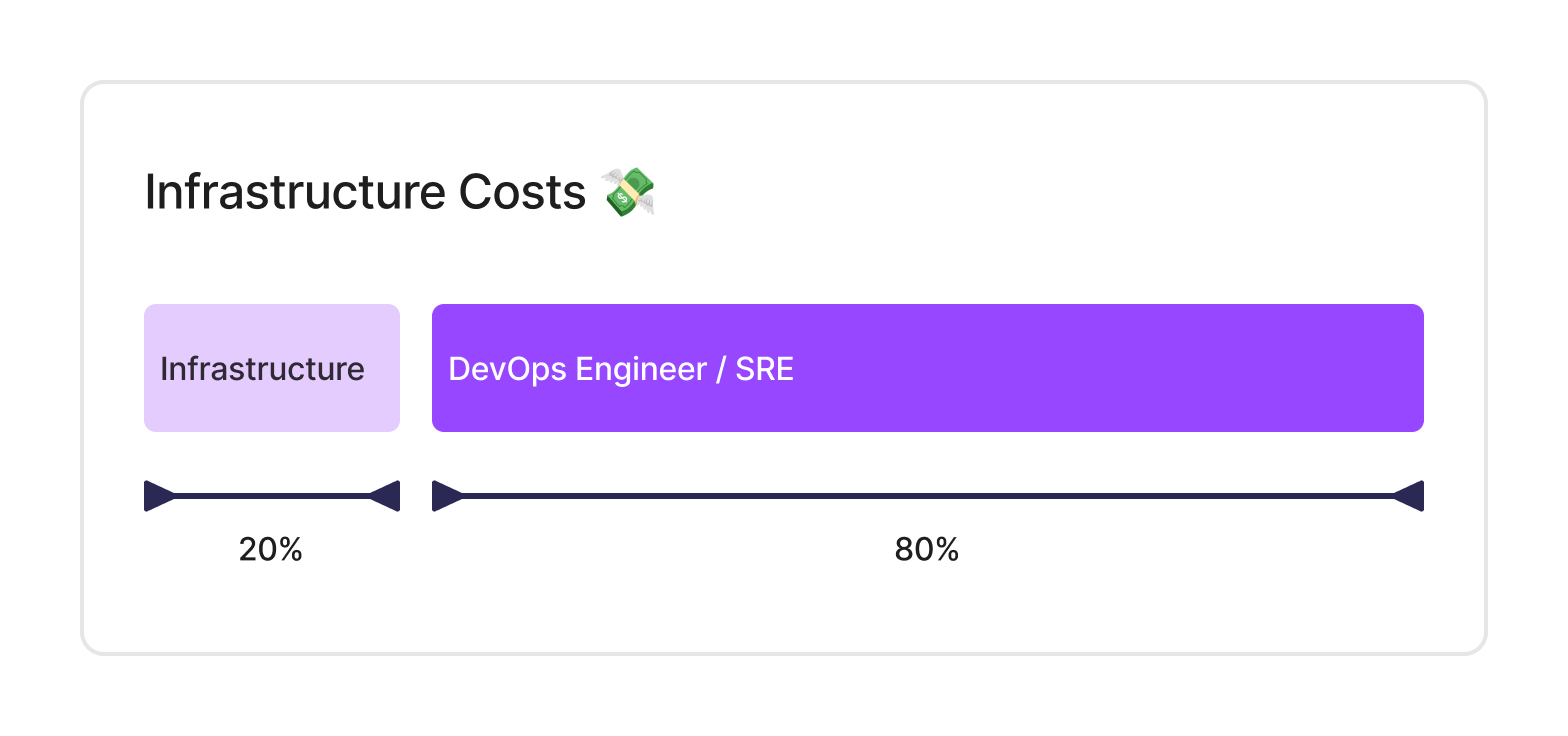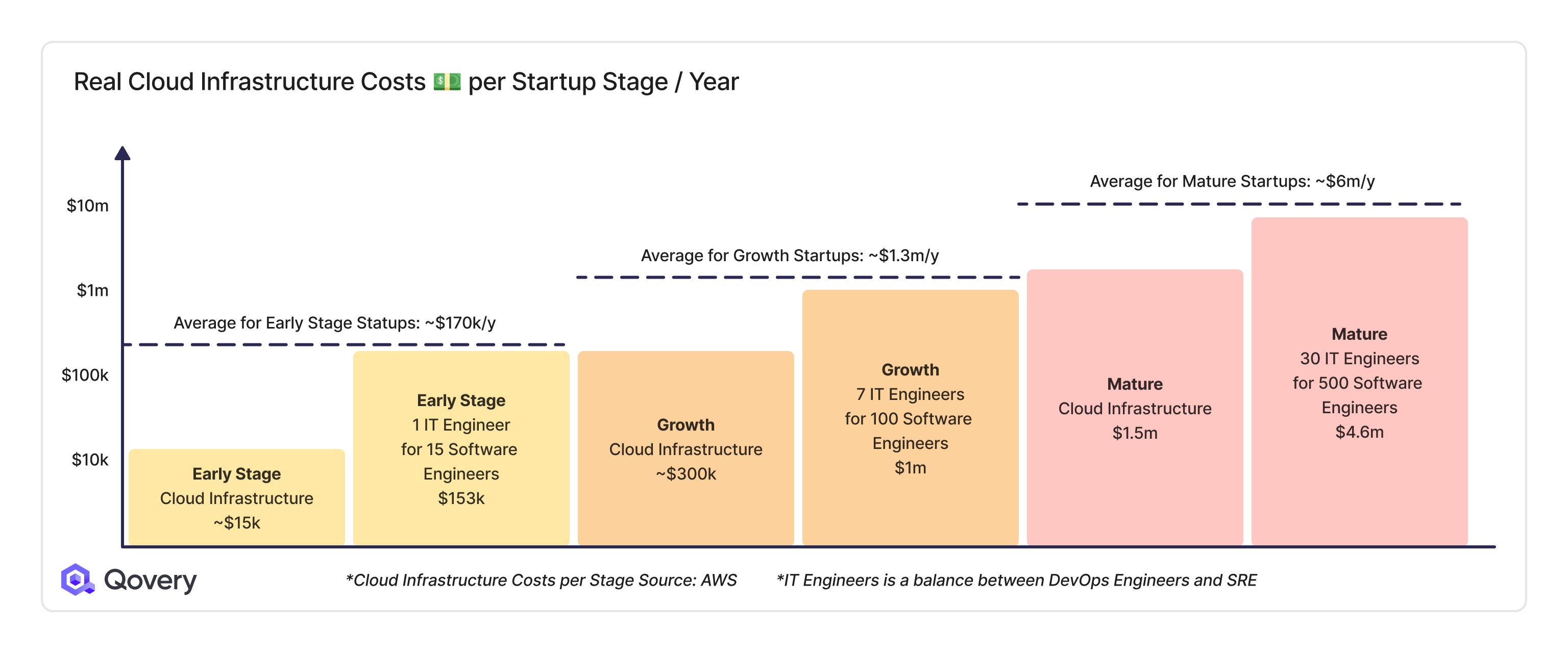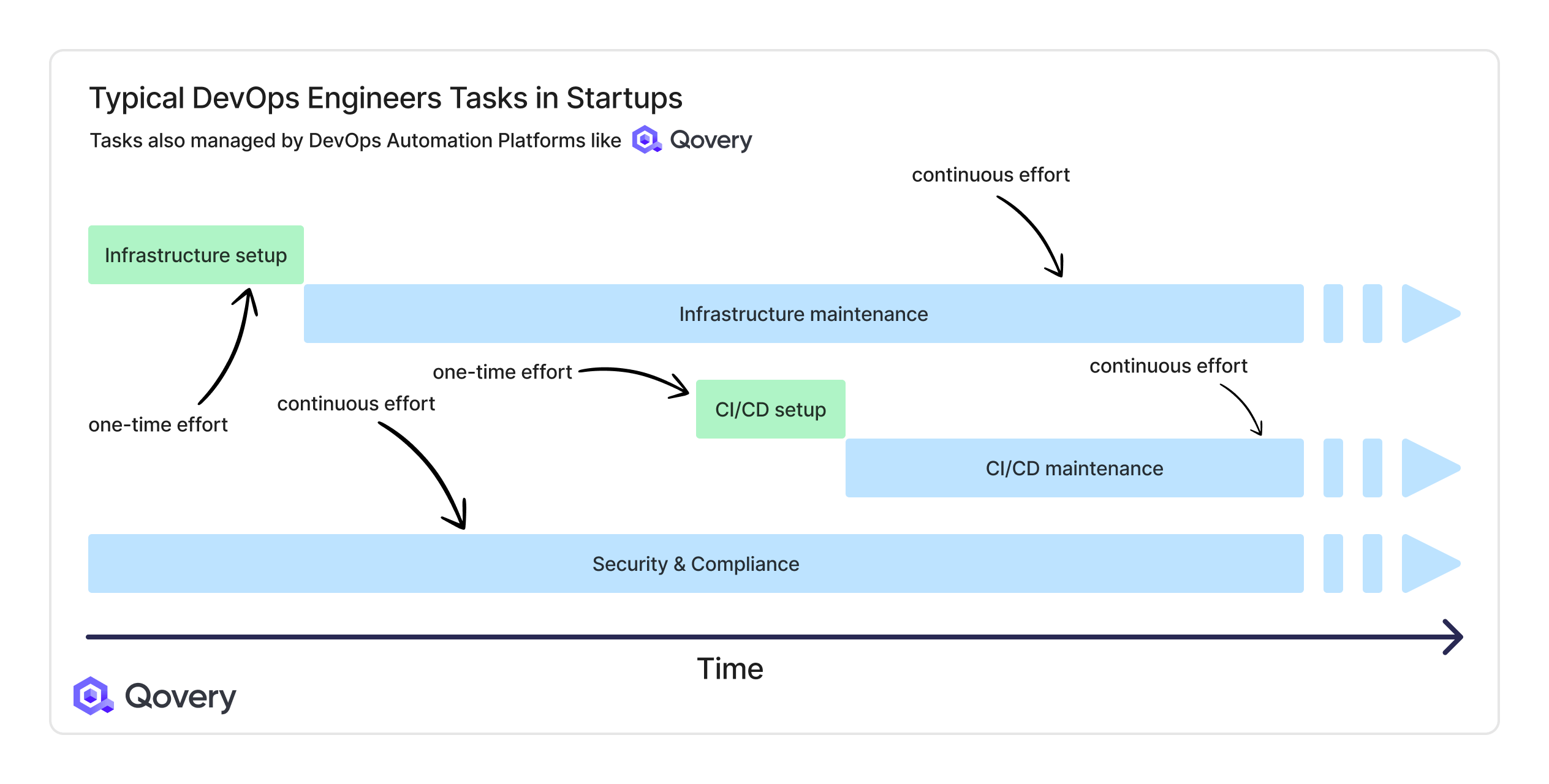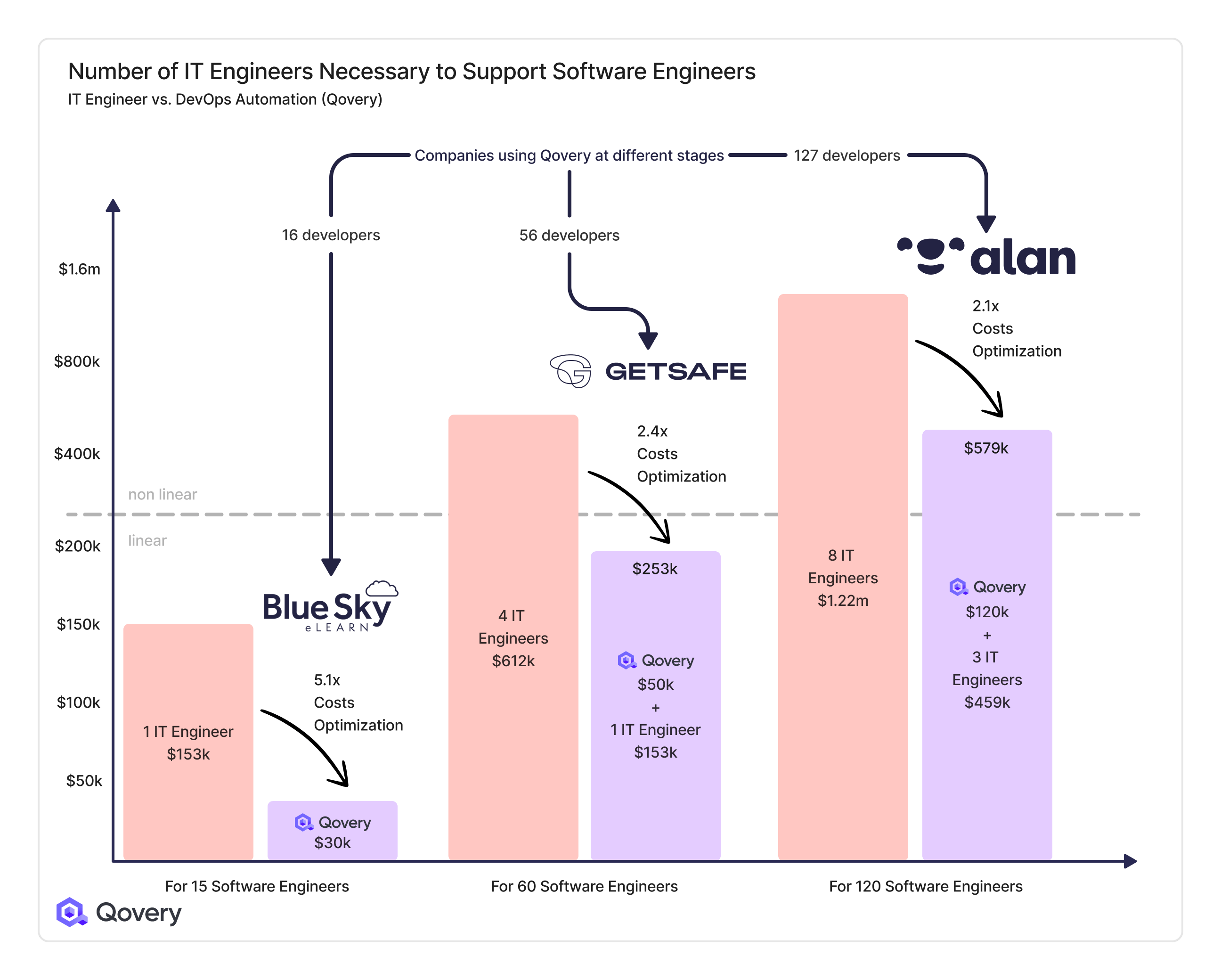Cut Cloud Infrastructure Costs By 5x - Guide For Startups
Managing costs while scaling operations is a challenging balancing act. One significant cost center is cloud infrastructure and its maintenance. This article aims to provide CTOs, VPs, and Head of Engineering with insights on optimizing these expenses. It highlights the benefits of leveraging DevOps Automation Platforms like Qovery to cut up to 5x their Cloud infrastructure costs.

Romaric Philogène
August 10, 2024 · 4 min read
#Main Cloud Infrastructure Costs

Cloud infrastructure costs can be divided into two main categories:
#Infrastructure Costs: 20%
- Compute: Virtual machines, containers, and serverless functions.
- Storage: Databases, object storage, and file storage.
- Networking: Load balancers, bandwidth, and DNS services.
Typically, these infrastructure components account for only 20% of the total cost of managing cloud infrastructure.
#Maintenance Costs: 80%
- DevOps Engineering / SRE Team: The personnel responsible for setting up, managing, and maintaining the infrastructure.
On the other hand, the costs associated with the DevOps/SRE teams generally represent a much larger portion, around 80% of the total cost. This includes salaries, tools, and the time spent on manual infrastructure management tasks.
80% of cloud costs are tied to DevOps and SRE team expenses.
Given that the bulk of cloud infrastructure costs — approximately 80% — are tied to the maintenance and management by DevOps and SRE teams, it's essential to rethink our approach to cost optimization. While it might seem intuitive to focus on reducing direct infrastructure expenses, the reality is that the most significant savings can be achieved by optimizing how we manage and maintain that infrastructure. This insight directs our attention to where the real money is spent and highlights the importance of efficiency in DevOps processes and automation.
#The Startup Phases

#Early Stage: No Official DevOps Engineer
At this phase, your startup typically has a non-official DevOps engineer— often a software engineer or your CTO — managing infrastructure. Cloud infrastructure costs are relatively low, around $15,000 annually, but the salary cost of this engineer is significant, $153,000 per year, making up 80% of your total infrastructure management costs.
#Growth Stage: Your First DevOps Engineer
As your startup scales to around 100 software engineers, your cloud infrastructure costs increase to approximately $1 million annually. To manage this, you typically have around 7 IT engineers, including DevOps and SRE roles. Despite the increased infrastructure costs, personnel expenses still account for a large portion of your budget, with total IT engineer costs rising significantly.
#Mature Stage: More DevOps Engineers
For mature startups with about 500 software engineers, cloud infrastructure costs can reach $1.5 million annually. At this point, you typically need around 30 IT engineers, and the cost for these engineers can reach $4.6 million per year. The personnel costs continue to dominate, making effective cost management critical to maintaining scalability and efficiency.
So the question is, how do you optimize those costs?
#Optimizing The Real Cloud Infrastructure Costs
This is where DevOps Automation Platforms like Qovery come into play. By automating many of the time-consuming tasks traditionally handled by DevOps engineers, these platforms can significantly reduce the overhead of infrastructure management.

#Key Benefits of DevOps Automation with Qovery:
- CI/CD Automation: Streamlines continuous integration and deployment processes, reducing manual intervention and errors.
- Infrastructure Management: Automates infrastructure components' setup, configuration, and scaling.
- Self-Service Capabilities: Provides developers with the tools they need to manage their environments, reducing the load on the DevOps team.
- Security and Compliance: Ensures infrastructure adheres to best practices and regulatory requirements like HIPAA, SOC2, and PCI DSS.
#Cost Efficiency Analysis

With a traditional setup, a U.S. company typically spends $153,000 annually for a DevOps engineer managing 15 developers. However, you can drastically reduce these costs using a DevOps Automation Platform like Qovery.
For example:
- For 15 Software Engineers: Instead of spending $153,000 on one IT engineer, you can reduce costs by over 5x, bringing it down to just $30,000 with Qovery.
- For 60 Software Engineers: The costs would traditionally rise to $612,000 for four IT engineers. By leveraging Qovery and retaining just one IT engineer, the costs can be optimized to $203,000, resulting in a 2.4x cost reduction.
- For 120 Software Engineers: In a more mature scenario, where you would typically spend $1.22 million on eight IT engineers, Qovery enables a more efficient setup with only three IT engineers, bringing the total cost to $579,000—a 2.1x reduction in costs.
Currently, Qovery can keep IT infrastructure costs lean for teams of up to 200 developers. We are also actively working on expanding our platform’s capabilities to support companies with up to 500 developers, ensuring that businesses of all sizes can continue to scale efficiently without a proportional increase in infrastructure management costs.
This efficiency is achieved by automating many routine and complex tasks, reducing the need for additional DevOps hires as your development team scales. By optimizing infrastructure and personnel expenses, startups can allocate their resources more effectively, allowing for greater scalability and growth without a linear cost increase.
#Conclusion
For CTOs and VP Engineering, optimizing cloud infrastructure costs reduces expenses and enables scalable growth. By adopting DevOps Automation Platforms like Qovery, startups can significantly lower their infrastructure management costs, allowing them to reinvest savings into other critical areas of their business.
In the competitive landscape of startups, making intelligent, strategic decisions about cloud infrastructure and maintenance can be a game-changer. Leveraging automation optimizes costs and enhances operational efficiency, positioning your startup for sustained growth and success.
By strategically managing cloud infrastructure and maintenance costs, you can focus on what truly matters: innovation and delivering value to your customers.
Optimize your infrastructure costs with Qovery now!
Your Favorite DevOps Automation Platform
Qovery is a DevOps Automation Platform Helping 200+ Organizations To Ship Faster and Eliminate DevOps Hiring Needs
Try it out now!

Your Favorite DevOps Automation Platform
Qovery is a DevOps Automation Platform Helping 200+ Organizations To Ship Faster and Eliminate DevOps Hiring Needs
Try it out now!